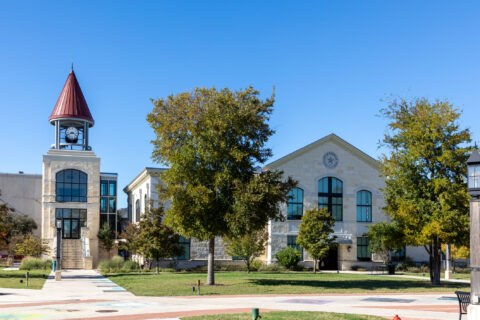Chatter about AI has become like the weather — talked about seemingly everywhere yet increasingly difficult to predict with absolute confidence. While the meteoric rise of generative, language-wielding platforms, like ChatGPT, are catching big media waves, many cities are already established AI enthusiasts. In the realm of urban sustainability, AI is being leveraged to bring real-time data to decision makers: assessing critical infrastructure conditions, monitoring air quality, and predicting the severity of storms and floods.
In the frenetic pace of AI development today, it’s important to understand what game-changing tools will enable local governments to meet their sustainability goals and how local governments can harness these technologies responsibly. Here are a handful of examples of how cities are putting AI to use in their work to become more sustainable, resilient, and future-ready.
Smart Mobility Solutions
Seattle, in partnership with Google, manages Project Green Light to automate traffic analysis and recommendations. Leveraging Google Maps data, the AI-powered tool identifies inefficient signal timings. These insights can lead to smoother traffic flow and reduced emissions. Early implementations showcase promising results, with the potential to slash stops by 30% and CO2 emissions by 10%.
Infrastructure Management

In Arizona, the Tucson Water Department partners with VODA.ai to implement AI software to proactively manage its extensive water infrastructure spanning more than 4,600 miles of distribution water main pipes. Machine learning technology offers continuous virtual condition assessment and predictions, enabling the city to make informed decisions on maintenance. By assigning Likelihood of Failure (LoF) scores and calculating risk for each pipe segment, the software allows utilities to focus resources effectively, ensuring the longevity and sustainability of the water system. This collaboration empowers Tucson to optimize asset management, safeguard critical infrastructure, and support the city’s goal of serving a growing population while preserving valuable resources.
Resource Efficiency
Generative AI also has the potential to help optimize energy efficiency in buildings. AI-powered systems can pair data from building sensors and HVAC systems with weather data to automatically send real-time commands to a building’s HVAC system to minimize emissions and energy consumption. Many cities have worked towards building decarbonization, and this tool will allow cities to further these efforts going forward.
Predictive Analytics with Digital Twins
The City of Las Vegas is using a digital twin, a virtual model of the city’s infrastructure and processes, to address energy use, emissions, traffic and more. This digital twin can model the impacts of various scenarios on the city’s emissions and can help inform city policies to address energy use and emissions. In the early stages of using the digital twin, the city is learning and experimenting with its uses. It intends to use the technology to model the environmental impacts of large-scale building projects and automate energy monitoring in their existing infrastructure.
Digital twins can also be used to model the impact of storms and other extreme weather events. Galveston, TX, a community on the Texas Gulf Coast, uses a digital twin to better understand how its planning and infrastructure decisions impact its resilience to flooding. Galveston’s digital twin can simulate the effects of flooding events under different hazard response scenarios to inform Galveston’s policy decisions around resilience efforts.

Generative AI for Environmental Forecasting
Generative AI has data analysis capabilities that can help cities interpret and utilize climate and environmental data. For example, AI platforms can integrate multiple data sources to monitor, govern and predict air quality on a highly localized scale. AI can help cities detect emergencies as they arise and produce personalized emergency response messages to warn residents and provide information on response. These use cases of generative AI are in their early stages but are promising tools that municipalities may utilize in the future.
AI Considerations and Recommendations
The use cases highlighted above demonstrate AI’s potential to accelerate progress toward cities’ climate resilience and energy objectives by providing decision-makers with invaluable tools and insights. However, integrating AI into urban strategies requires careful consideration. Here are some key factors to bear in mind:
- Align with Sustainability Goals: AI isn’t a cure-all. It’s crucial for local leaders to begin with clear sustainability objectives. How can AI complement and enhance existing strategies and practices?
- Ethical Implementation: With the power of AI comes significant responsibility. Decision-makers should prioritize transparency and accountability in AI systems, avoiding black-box approaches. Keeping human decision-makers involved and accountable helps maintain ethical standards.
- Environmental Impact: Generative AI, while powerful, has a notable environmental footprint. Training and operating large language models consume substantial electricity. It’s essential to weigh the environmental costs against the benefits of AI adoption. While AI can potentially mitigate its own environmental impact by optimizing renewable energy systems, the balance between gains and energy consumption warrants careful consideration. (For perspective, generative AI creating one image demands as much energy as charging a phone.)
- Financial Sustainability: Cities must consider the costs associated with adopting AI, especially with generative AI models. While these technologies offer significant benefits, they come with expenses such as licensing fees and infrastructure investments. Leaders should assess whether they can sustainably integrate AI into their operations and explore funding options like public-private partnerships.










